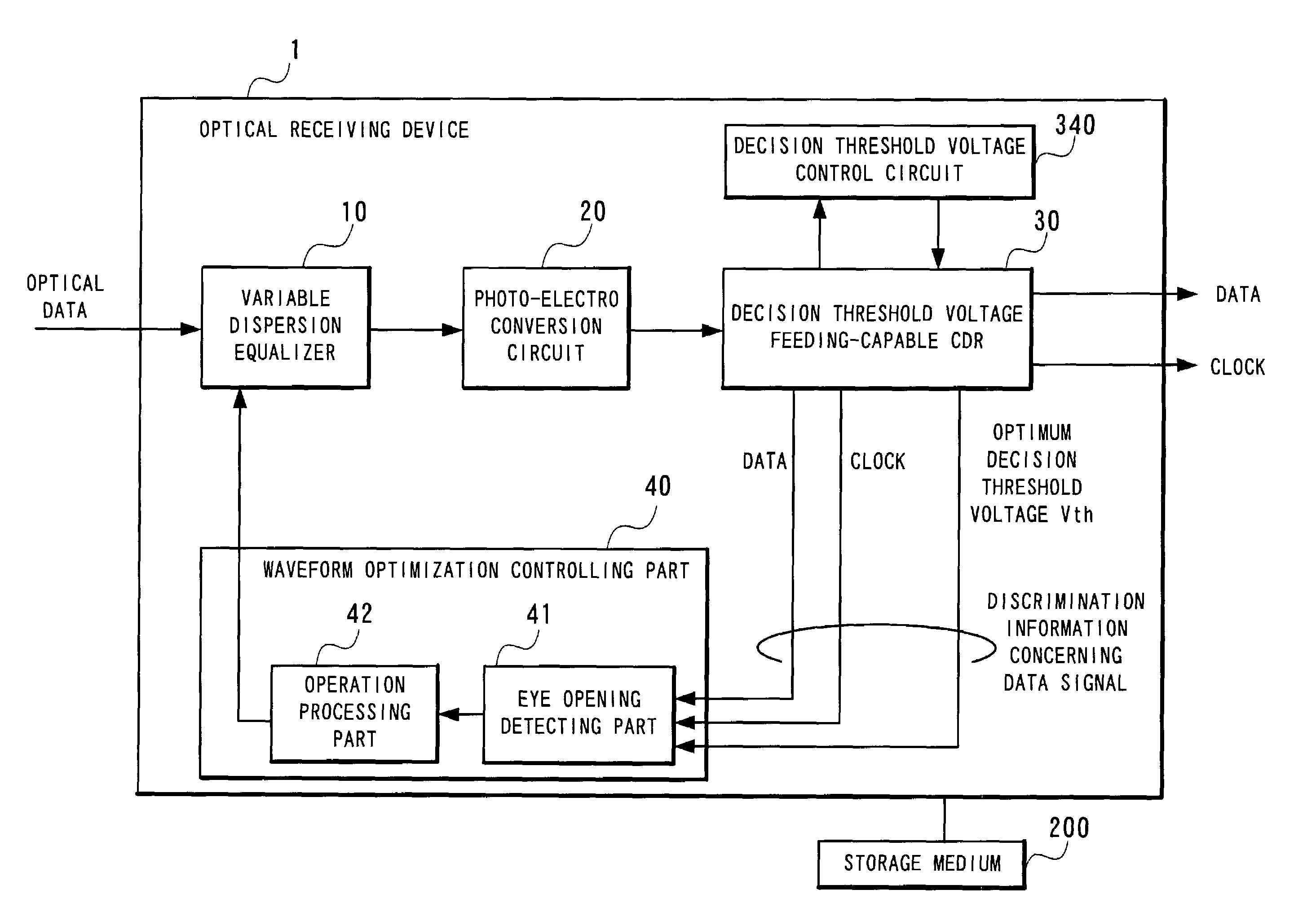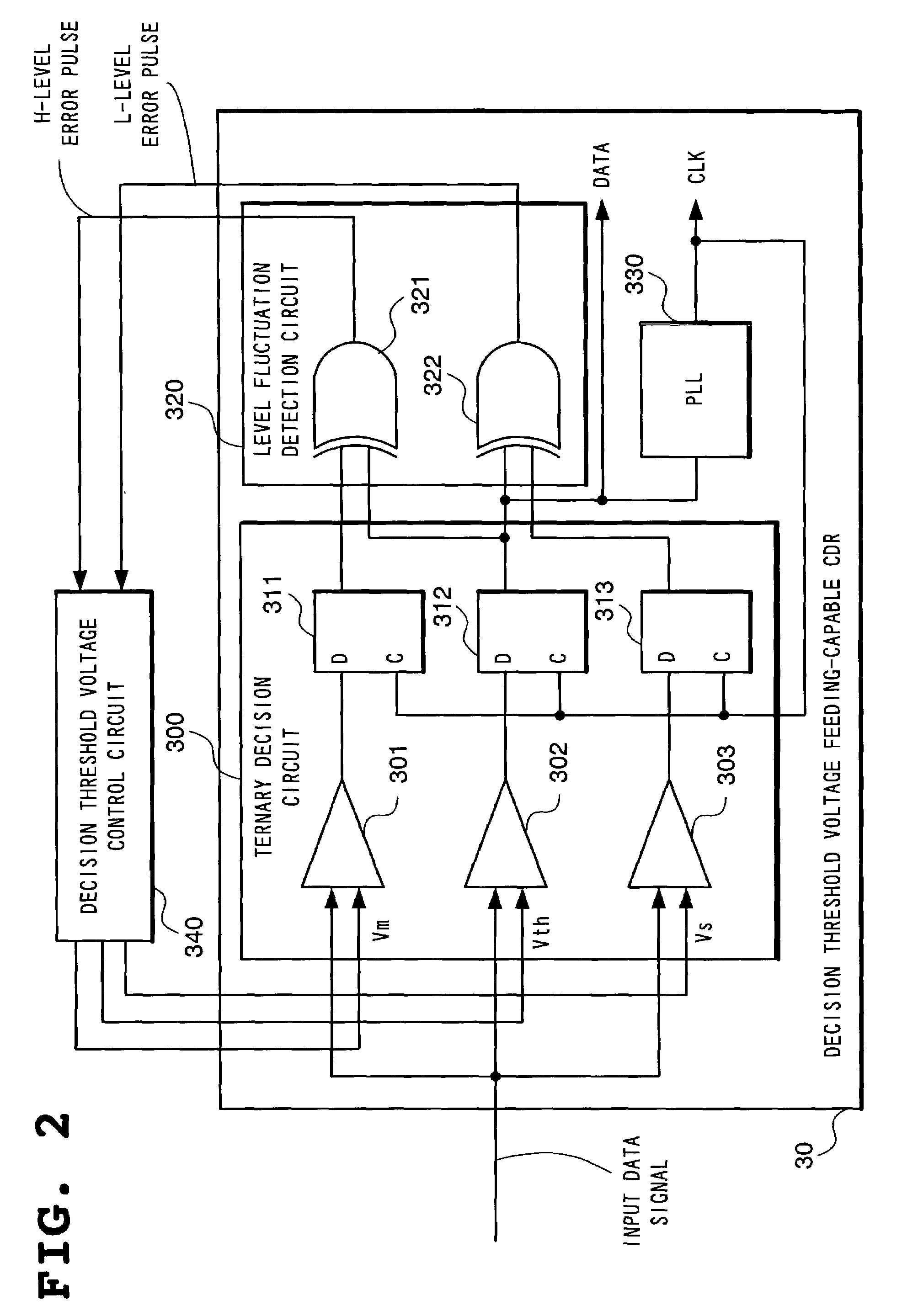Optical receiving device, waveform optimization method for optical data signals, and waveform optimization program for optical data signals
a technology of optical data signals and waveform optimization methods, applied in the direction of digital signal error detection/correction, recording signal processing, instruments, etc., can solve the problems of increasing waveform deterioration, deterioration of optical receive waveform, accumulation of noise, etc., to optimize optical waveform, optimize optical data signal waveform, optimize optical waveform
- Summary
- Abstract
- Description
- Claims
- Application Information
AI Technical Summary
Benefits of technology
Problems solved by technology
Method used
Image
Examples
first embodiment
[0116]While the present invention can be applied to both optical receiving devices and repeating installations, this section will specifically describe the first embodiment featuring its application to an optical receiving device. FIG. 1 is a block diagram showing the configuration of an optical receiving device according to the first embodiment of the present invention.
[0117]According to this embodiment, an optical receiving device 1 comprises a variable dispersion equalizer 10, a photo-electro conversion circuit 20, a decision threshold voltage feeding-capable CDR 30, and a waveform optimization controlling part 40. The waveform optimization controlling part 40 includes an eye opening detecting part 41 and an operation processing part 42.
[0118]As shown in FIG. 8, the variable dispersion equalizer 10 is characterized by its ability to change the inclination of wavelength dispersion characteristics by controlling the temperature of the dispersion equalizer through use of a Peltier d...
second embodiment
[0160]The second embodiment of the present invention will now be described with reference to FIGS. 13, 14, and 15.
[0161]FIG. 13 is a diagram illustrating the control algorithm for the operation processing part 42 according to the second embodiment. FIG. 14 shows a flow chart realizing such control algorithm operation. FIG. 15 is a diagram showing the relationship between the dispersed value D and the size of the eye opening P.
[0162]The second embodiment adopts another idea of Step 903 in FIG. 9, which determines whether to increment or decrement the dispersed value D by comparing between the current and previous measurements of the size of the eye opening.
[0163]As with the first embodiment, this embodiment begins with the minimum value D0 of the dispersed value D and increments it by ΔD with every increase (improvement) in the size of the eye opening.
[0164]This embodiment differs from the first embodiment in that, as seen from Step 903B for the control algorithm in FIG. 13, the algo...
third embodiment
[0173]The third embodiment of the present invention will now be described with reference to FIGS. 16, 17, and 18.
[0174]FIG. 16 is a diagram illustrating the control algorithm for the operation processing part 42 according to the third embodiment. FIG. 17 is a flow chart realizing such control algorithm operation. FIG. 18 is a diagram showing the relationship between the dispersed value D and the size of the eye opening P.
[0175]The third embodiment adopts yet another idea for Step 903 in FIG. 9, which determines whether to increment or decrement the dispersed value D by comparing between the current and previous measurements of the size of the eye opening.
[0176]This embodiment is similar to the second embodiment in that the algorithm begins with the minimum value D0 of the dispersed value D and increments it by ΔD with every increase (improvement) in the size of the eye opening and that the algorithm switches the operational direction from increase to decrease if the size of the eye ...
PUM
 Login to View More
Login to View More Abstract
Description
Claims
Application Information
 Login to View More
Login to View More - R&D
- Intellectual Property
- Life Sciences
- Materials
- Tech Scout
- Unparalleled Data Quality
- Higher Quality Content
- 60% Fewer Hallucinations
Browse by: Latest US Patents, China's latest patents, Technical Efficacy Thesaurus, Application Domain, Technology Topic, Popular Technical Reports.
© 2025 PatSnap. All rights reserved.Legal|Privacy policy|Modern Slavery Act Transparency Statement|Sitemap|About US| Contact US: help@patsnap.com



